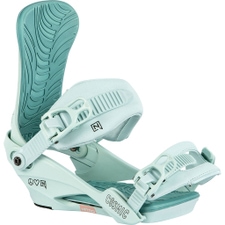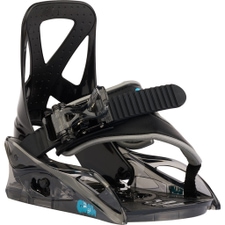Snowboard bindings

- - 20 %
 BurtonCartel X Snowboard Bindings Gray/Logo MenMSRP 369,95 €294,95 €Available Sizes:SM
BurtonCartel X Snowboard Bindings Gray/Logo MenMSRP 369,95 €294,95 €Available Sizes:SM - - 30 %
 NitroTeam Snowboard Bindings MenMSRP 349,90 €244,95 €Available Sizes:L
NitroTeam Snowboard Bindings MenMSRP 349,90 €244,95 €Available Sizes:L - - 20 %
 BurtonScribe Re:Flex Snowboard Bindings Black WomenMSRP 249,95 €199,95 €Available Sizes:SL
BurtonScribe Re:Flex Snowboard Bindings Black WomenMSRP 249,95 €199,95 €Available Sizes:SL - - 20 %
 BurtonCitizen Snowboard Bindings Elderberry WomenMSRP 199,95 €159,95 €Available Sizes:L
BurtonCitizen Snowboard Bindings Elderberry WomenMSRP 199,95 €159,95 €Available Sizes:L - - 30 %
 NitroRambler Snowboard Bindings MenMSRP 249,90 €174,95 €Available Sizes:L
NitroRambler Snowboard Bindings MenMSRP 249,90 €174,95 €Available Sizes:L - - 20 %
 Jones SnowboardsOrion Snowboard Bindings Black/Art MenMSRP 399,95 €319,95 €Available Sizes:L
Jones SnowboardsOrion Snowboard Bindings Black/Art MenMSRP 399,95 €319,95 €Available Sizes:L - - 30 %
 NitroCosmic Snowboard Bindings WomenMSRP 249,90 €174,95 €Available Sizes:S/M
NitroCosmic Snowboard Bindings WomenMSRP 249,90 €174,95 €Available Sizes:S/M - - 24 %
 Rome Snowboards390 Boss Snowboard Bindings BlackMSRP 329,95 €249,95 €Available Sizes:LXL
Rome Snowboards390 Boss Snowboard Bindings BlackMSRP 329,95 €249,95 €Available Sizes:LXL - - 35 %
 Rome Snowboards390 Boss Snowboard Bindings VioletMSRP 329,95 €214,95 €Available Sizes:LXL
Rome Snowboards390 Boss Snowboard Bindings VioletMSRP 329,95 €214,95 €Available Sizes:LXL - - 30 %
 NitroTeam Snowboard Bindings MenMSRP 349,90 €244,95 €Available Sizes:ML
NitroTeam Snowboard Bindings MenMSRP 349,90 €244,95 €Available Sizes:ML  BurtonStep On Snowboard Bindings Black Men329,95 €Available Sizes:LXL
BurtonStep On Snowboard Bindings Black Men329,95 €Available Sizes:LXL BurtonStep On Snowboard Bindings Black Women329,95 €Available Sizes:ML
BurtonStep On Snowboard Bindings Black Women329,95 €Available Sizes:ML- - 30 %
 NitroRythm Snowboard Bindings Black Bronze WomenMSRP 199,90 €139,95 €Available Sizes:S
NitroRythm Snowboard Bindings Black Bronze WomenMSRP 199,90 €139,95 €Available Sizes:S - - 29 %
 UnionCadet Snowboard Bindings Black KidsMSRP 139,95 €99,95 €Available Sizes:SM
UnionCadet Snowboard Bindings Black KidsMSRP 139,95 €99,95 €Available Sizes:SM - - 29 %
 NitroCharger Snowboard Bindings KidsMSRP 169,90 €119,95 €Available Sizes:M
NitroCharger Snowboard Bindings KidsMSRP 169,90 €119,95 €Available Sizes:M - - 21 %
 BurtonGrom Snowboard Bindings Black KidsMSRP 119,95 €94,95 €Available Sizes:M
BurtonGrom Snowboard Bindings Black KidsMSRP 119,95 €94,95 €Available Sizes:M - - 25 %
 NitroMini Charger Snowboard Bindings Black KidsMSRP 159,90 €119,95 €Available Sizes:S
NitroMini Charger Snowboard Bindings Black KidsMSRP 159,90 €119,95 €Available Sizes:S - - 22 %
 BurtonMission Smalls Snowboard Bindings Black KidsMSRP 179,95 €139,95 €Available Sizes:L
BurtonMission Smalls Snowboard Bindings Black KidsMSRP 179,95 €139,95 €Available Sizes:L - - 50 %
 Rome Snowboards390 Boss Snowboard Bindings ArtifactMSRP 299,95 €149,95 €Available Sizes:S
Rome Snowboards390 Boss Snowboard Bindings ArtifactMSRP 299,95 €149,95 €Available Sizes:S

Snowboard bindings are the heart of snowboarding - they connect you to your board. Through the binding you transfer your power and your movements to the snowboard. And that's exactly why the right binding is so important: it can guarantee you real riding fun or ruin your whole day. But what is important when buying a snowboard binding? We show you what features the different bindings have and what systems and technologies are available on the market:


Flex, 3D, Clicker - these terms are like Bohemian villages for you? No problem, we bring light into the darkness!
The flex and your skills
On some bindings you will find a numerical indication of the flex. This information tells you about the flexibility of your binding. Depending on the materials and construction methods used, your binding can be soft (flex 1-4), medium (flex 4-7) or rather stiff (flex 7-10).
Soft bindings
These bindings are more forgiving of your mistakes because of the increased flexibility. So if you are more of a beginner, a low flex is right for you. But also friends of freestyle are well advised with a soft flex: The flexibility is important for cool jumps.
Medium bindings
A medium flex offers the optimal middle ground when it comes to bindings. The material is slightly stiffer in this flex category, which gives you more control over your board. Especially experienced snowboarders who like to ride all-mountain appreciate the medium flex very much.
Stiff bindings
Medium is not enough for you? Then go for stiff bindings. With them you feel every turn and can carve down the slopes nimbly. Stiff bindings give you a lot of control over the board through direct power transmission. You also benefit from stiff bindings when freeriding, due to the improved performance.

Four types of bindings
Sounds complicated at first, but it's actually quite simple: basically there are four systems, but two of them are very similar and most boards work with them.
The 2x4 binding
In a 2x4 system, the inserts (the holes on the board) are placed at a vertical distance of 2 cm (tip to tail) and a distance of 4 cm between the rows (edge to edge). The disc of your binding is mounted on these holes. In total there are 24 inserts (12 per foot) and the nice thing is that this binding system is compatible with almost all bindings. The 2x4 system is basically the standard.
The 4x4 binding
This binding has inserts spaced 4 cm vertically and 4 cm between rows. In sum, with a 4x4 system you will find fewer holes, which you can use for optimal mounting of your binding. But this system is also compatible with almost all bindings, although they are hardly available anymore.
Burton 3D-Inserts
This system has also become rather rare. Although it also works with inserts, like the previously mentioned systems, but in the form of a triangle. As a result, this system does not offer compatibility with 2x4 or 4x4 bindings. You need a special 3D disk for this. This binding system can only be found on old Burton boards or on Burton kids boards.
The Channel System (ICS/EST)
The Channel System (previously ICS), is only available on Burton snowboards. Unlike the traditional system with inserts and disc, here there is only one joint where your binding is mounted. This system allows you to adjust the binding to the millimeter by sliding it along the joint.
Before you decide on a binding system, be sure to check the compatibility with the boards, not everything fits on all!

The Fitting
A secure hold in the binding is necessary for your perfect snowboard adventure. Now that you know the differences in mounting and flexibility of snowboard bindings, let's find out what options you have to strap your boots into the binding:
Strap-In Bindings
They represent the classic model of snowboard binding and are still the most widespread. The binding consists of two adjustable straps (one over the toes and one at the ankle), a baseplate (chassis, frame of your binding and connection between your board and your boot) and a highback, the vertical plate behind your boot. This model offers the optimal support and can be adjusted well according to your individual comfort.
Rear-Entry Bindings
With these bindings, also called speed-entry bindings, you can fold down the highback completely and slip into the binding from behind with your boots. To fix your boot now you just have to pull up the highbacks and close the lever. The straps of the binding are adjustable in size, so that you can adapt them to the rest of your equipment.
Step-In Bindings
This binding offers you maximum comfort. You no longer have to bend down to open or close your buckles, but can step into the binding with a simple click with your shoe. Attention: The shoe must fit! There is the Step-On System from Burton or also the Clicker-Bindug from K2.
